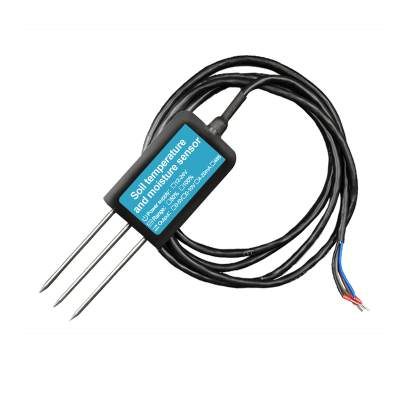In the ever-evolving landscape of agriculture, technology continues to play a pivotal role in transforming traditional farming practices into more efficient, sustainable, and profitable ventures. One such technological advancement that is making waves in the agricultural sector is the emergence of new soil sensor technology. These innovative devices are revolutionizing the way farmers monitor and manage their soil, ultimately leading to improved crop yields, reduced environmental impact, and enhanced overall farm productivity.

The Evolution of Soil Sensing
The concept of soil sensing is not entirely new. For decades, farmers have relied on various methods to assess soil conditions, ranging from simple visual inspections to more complex laboratory analyses. However, these traditional methods are often time-consuming, labor-intensive, and provide only a snapshot of soil health rather than continuous, real-time data.
Enter the new generation of soil sensors. These advanced devices leverage cutting-edge technology, such as the Internet of Things (IoT), artificial intelligence (AI), and machine learning, to provide farmers with unprecedented insights into their soil’s composition, moisture levels, nutrient content, and other critical parameters. By collecting and analyzing data in real-time, soil sensors enable farmers to make informed decisions that optimize crop growth and resource utilization.
The Benefits of Soil Sensors
The benefits of soil sensor technology are manifold. Firstly, these devices enhance precision agriculture practices. By providing accurate, real-time data on soil conditions, sensors enable farmers to tailor their farming operations to the specific needs of their fields. This precision approach reduces the risk of over- or under-applying fertilizers, water, and pesticides, which not only saves costs but also minimizes environmental pollution.
Secondly, soil sensors contribute to sustainable farming. By optimizing resource use and reducing chemical inputs, farmers can adopt more environmentally friendly practices that preserve soil health and biodiversity. This is particularly important in the face of climate change, as healthy soils are better able to sequester carbon and mitigate the effects of global warming.
Furthermore, soil sensors improve crop yields and quality. By monitoring soil conditions continuously, farmers can identify and address potential issues before they become problematic. For example, if a sensor detects a drop in soil moisture levels, farmers can irrigate their fields promptly, preventing crop stress and ensuring optimal growth conditions. Similarly, by monitoring nutrient levels, farmers can adjust their fertilization strategies to meet the specific needs of their crops, resulting in healthier plants and higher-quality produce.
The Technology Behind Soil Sensors
Soil sensors utilize a variety of technologies to collect and analyze data. Some sensors measure soil moisture content using capacitance or resistivity techniques, while others assess nutrient levels through spectrophotometry or electrochemical methods. Still, others monitor soil temperature, pH, and electrical conductivity to provide a comprehensive picture of soil health.
The data collected by these sensors is then transmitted to a central platform, often via wireless communication technologies such as Wi-Fi, Bluetooth, or cellular networks. This allows farmers to access real-time soil data from anywhere, at any time, using their smartphones, tablets, or computers.
Moreover, many soil sensor systems incorporate AI and machine learning algorithms to analyze the collected data and provide actionable insights. These algorithms can identify patterns, trends, and anomalies in soil conditions, enabling farmers to make data-driven decisions that optimize their farming operations.
Case Studies and Success Stories
The impact of soil sensor technology on agriculture is already evident in numerous case studies and success stories. For example, in a recent study conducted in a midwestern state in the United States, farmers who used soil sensors to monitor their fields experienced a significant increase in crop yields and a reduction in fertilizer and water use. The sensors provided real-time data on soil moisture and nutrient levels, allowing the farmers to adjust their irrigation and fertilization strategies accordingly.
In another instance, a group of smallholder farmers in a developing country adopted soil sensor technology to improve their farming practices. The sensors enabled them to monitor soil conditions more accurately and make informed decisions about planting, fertilization, and harvesting. As a result, the farmers reported increased crop yields, improved soil health, and higher incomes.
Challenges and Future Outlook
Despite the numerous benefits of soil sensor technology, there are also challenges to its widespread adoption. One of the main barriers is the cost of the sensors and the associated infrastructure required for data transmission and analysis. However, as the technology continues to evolve and become more affordable, it is expected that more farmers will adopt soil sensors to improve their farming operations.
Another challenge is the need for training and education. Farmers must be equipped with the knowledge and skills to use soil sensors effectively and interpret the data they provide. This requires investment in training programs and extension services that can help farmers understand the technology and its potential applications.
Looking to the future, the potential for soil sensor technology in agriculture is vast. As the technology continues to advance, we can expect to see even more sophisticated sensors that provide even more detailed and accurate data on soil conditions. Furthermore, the integration of soil sensors with other agricultural technologies, such as drones, autonomous tractors, and smart irrigation systems, could lead to a fully automated and intelligent farming ecosystem.
In conclusion, new soil sensor technology is revolutionizing agriculture by providing farmers with unprecedented insights into their soil’s health and productivity. These advanced devices enhance precision agriculture practices, contribute to sustainable farming, and improve crop yields and quality. Although there are challenges to their widespread adoption, the potential benefits of soil sensors are too significant to ignore. As the technology continues to evolve and become more affordable and accessible, we can expect to see more farmers embracing soil sensors as an essential tool in their farming operations.